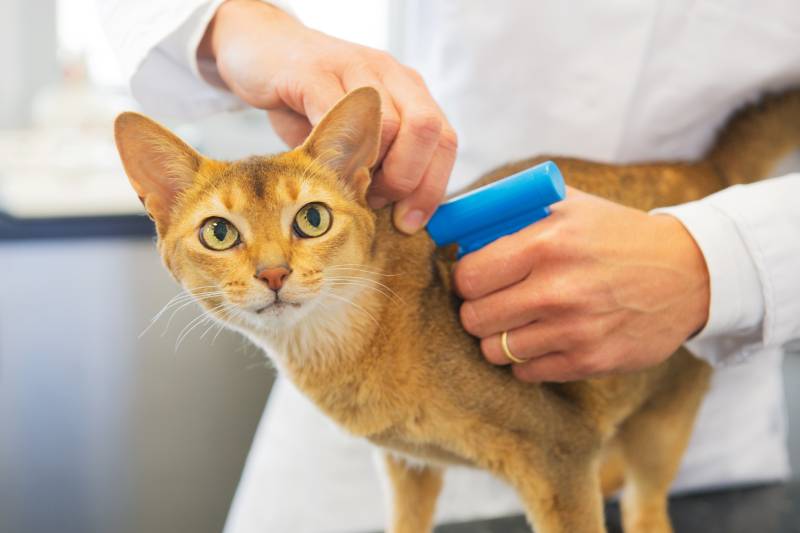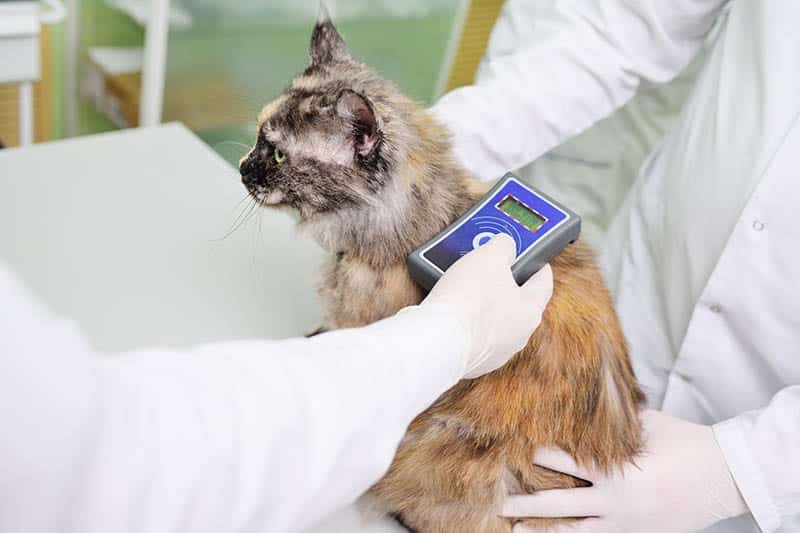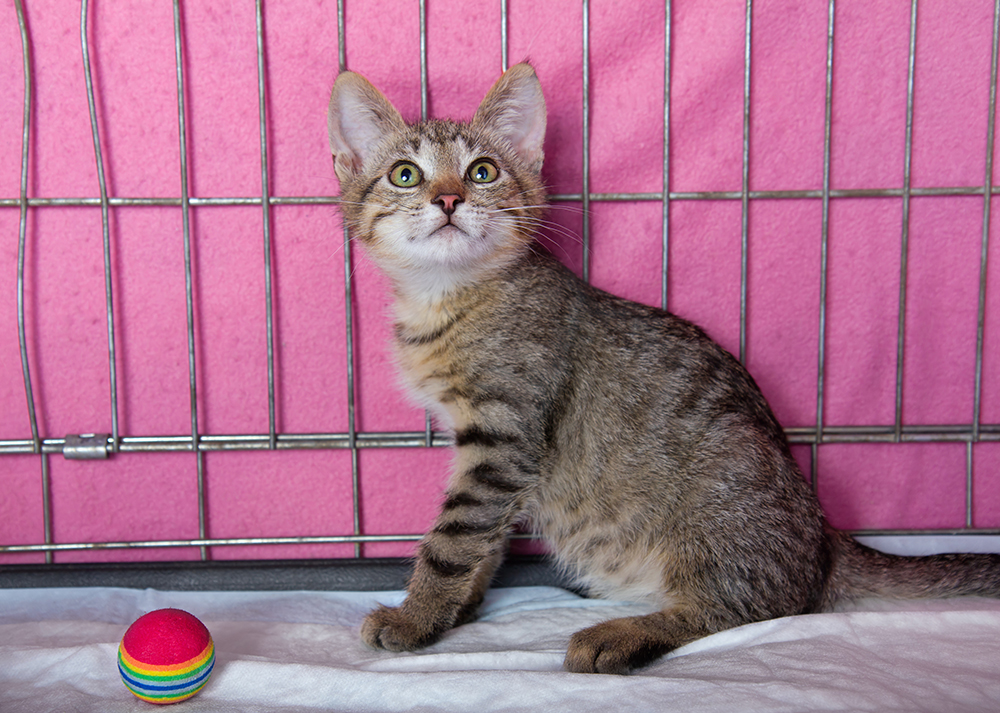It’s been on the cards since dog microchipping became compulsory in the UK, and from June 2024, it’s now legally required that all pet cats in England are microchipped before they reach 20 weeks of age.
Breeders are not required to chip cats before selling them, but most rescues will do so and include the price of chipping in the adoption fees. Owners not only enjoy the benefits of complying with the law, but they can enjoy a higher chance of reuniting a lost cat sooner than if the cat had not been chipped.

What is Microchipping?
When a cat is microchipped, a small microchip inside medical glass is inserted just under the skin, usually between the shoulder blades. If the cat goes missing and is recovered by a vet or rescue, they will be able to scan the cat. Scanning the cat provides a microchip ID (a unique serial number) which can be checked against the relevant microchip database, which contains contact details for the cat’s owners.
The owner is called, and they can be reunited with the cat, usually within hours, rather than days. This puts less pressure on rescues and shelters and ensures faster reunification of lost pets and caring owners.

UK Microchipping Law
By 2024, around three-quarters of UK pet cats are believed to be microchipped. Although this represents a large majority of the cat population, this still means that approximately 2.4 million domestic cats are not microchipped.
The government introduced a new law that came into effect in June 2024 and requires all owners in England to microchip their cats before they reach the age of 20 weeks. Owners who fail to have their cats chipped face fines of up to £500 and may struggle to get their cats back in some cases. Currently the law only applies to cats in England, and is not mandatory for free-living cats with little or no human contact such as feral cats.

The Benefits of Microchipping
The main benefits of cat microchipping are:
- Easier for Rescues and Shelters – Usually, when someone sees a lost or stray cat, their first port of call is a local shelter or rescue. This puts a lot of pressure on the rescue, and it means they end up housing, feeding, and caring for the animal. If the cat is chipped, they are usually returned to their owner within hours and after a scan and a quick phone call to the owner, making it easier for rescues.
- More Chances of Rehoming Cats – Sadly, when cats go missing, they can travel far from their home, making it difficult to find a missing cat. If the cat has a bite, it is more likely to find its way home. And, if the worst happens, a veterinarian or warden can let the owner know what happened to their cat. As heartbreaking as it is, that means they can stop looking.
- Owners and Cats Reunited – Finding a lost cat means putting up posters, calling rescues and shelters, and knocking on neighborhood doors. It may take several days or longer for a cat to be returned. If a cat is found, most will take it to a local shelter, where it will be scanned, and if it has a chip, it can be returned to its home within hours instead of days.
- Avoid fines – Failure to microchip a cat can land the owner with a fine of up to £500. Paying the £30 chipping fee not only helps ensure a quicker return of the cat if it goes missing, but it can also save the owner having to pay a £500 fine.
The Microchipping Method
Microchipping is a simple and relatively painless procedure. A microchip is about the size of a grain of rice and consists of a small, electronic chip enclosed in a cylinder of medical glass. It is injected under the skin between the shoulder blades with a needle, usually by a veterinarian. Although the needle is larger than most injections, it is quick and relatively painless, just like a normal injection. The procedure takes seconds, there is usually no need to shave the area, and the cat can go straight home after the chip is inserted.

Change of Details
Once the chip is inserted, the new owner’s details are sent to whichever company manages the microchip database. If the cat has been rehomed, the old owner needs to contact the database company to register the new owner’s details with them. If the owner changes their address or phone number, they need to update the details in the database.
What to Do If You Lose a Microchipped Cat
If you lose a cat that has been microchipped, you should still find the cat. Check buildings like sheds and garages and call around and check with neighbors. You should also check if the database details are current, and you can start calling around rescues and shelters.
Also check with local vets, as some people will take cats they find to vets rather than shelters.

Frequently Asked Questions
Can I Get My Cat Free?
There are some animal charities and organizations that microchip cats for free, but most vets charge a fee to perform the procedure. Charities may offer the service for free to owners who are on low incomes or receive certain benefits, and it’s worth checking if you believe you may be eligible.
How Much Does Cat Microchipping Cost in the UK?
Costs vary from one vet or one location to the next, but the microchipping process usually costs between £10 and £30. It may be possible to get the procedure for free, and most rescues and shelters ensure that all their cats are microchipped before they are adopted.
There may be a charge if you need to change the address details or telephone number stored in the database, but the company must inform you of these charges when you join.
What Should I Do If I Find a Chipped Cat?
If you see a missing or stray cat, take it to a local veterinarian or animal shelter. They will be able to scan the cat to find a chip and then find the owner using the details stored in the microchip database. You may be asked to hold the cat until the owner is found, but most vets and shelters will hold the cat during that time.

Does a Microchip prove ownership of a cat?
A microchip is not considered absolute proof of ownership, but if there is a dispute, it can be presented as evidence, and it can help ensure that your cat is returned to you in the event of theft.
Can I microchip my cat myself?
Cat microchipping means injecting a microchip under your cat’s skin and the procedure needs to be carried out by a professional, who will also register the microchip details as part of the procedure. You should not attempt to perform the procedure yourself.

Conclusion
Microchipping helps ensure that lost cats are reunited with their owners and also helps relieve the burden on rescues and shelters. From June 2024, it is a legal requirement that all domestic cats in England are microchipped before they reach 20 weeks of age.
Failure to have a cat microchipped can lead to a fine of up to £500 and will delay the return of the cat to you, should they ever go missing. The procedure is quick, painless, and inexpensive, and can be performed by your cat’s veterinarian whose details will be provided to a reputable cat database company.
Featured Image Credit: Lucky Business, Shutterstock


